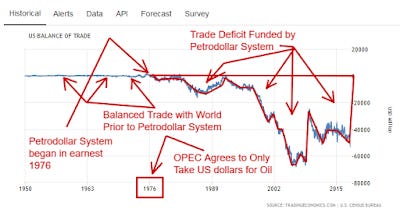Eliminating Trade Deficit Pays for Wall
Last June, I published an article here entitled, “Trump Goes After the Fed—Attacks Trade Deficit.” In that article, I explained how the US Trade deficit has been funded not by any equitable arrangement, such as trading real value created in America for value from other countries, but by the petrodollar system. And since 1976 when the petrodollar began in earnest, the private banks of the Federal Reserve System have been able to print dollars with impunity, loaning them into the American economy, where Americans have borrowed them only to send them overseas to import goods produced cheaper than we can produce them here at home. Since 1976, there have always been more dollars leaving America to import goods, than returning to buy our exports. Consequently, American jobs have gone with the dollars to other countries. The measure of the difference between the dollars leaving and the dollars returning is the “US trade deficit.”

1976 was a hinge point world trade history. That was the year the nations of the world found themselves not choosing or agreeing, but coerced to using US dollars, issued by private Federal Reserve Banks, to buy the OPEC energy products necessary to run their economies, a great arrangement for the banks, but a nightmare for everyone else. Since that year, private banks have been flooding the US economy with worthless paper, the American people have been borrowing it, signing onto debt as they do, and sending them out of the country in exchange for cheap stuff produced abroad, lately at a clip of $400 to $800 annually. What the “free trade” globalist proponents don’t want you to know is that each dollar accounted in the annual trade deficit is one more dollar of debt the American people and their government must borrow to operate the domestic US economy. The trade deficit is a debt-creation machine. And whereas the cheap stuff Americans import generally depreciates, the debt they accrue appreciates exponentially.

The US trade deficit is a silent killer for the American way of life. That is one reason Trump wants to eliminate it and create national self-sufficiency. Were America to achieve a trade balance each year, as it did prior to 1976, that would eliminate $400 to $800 billion in domestic borrowing annually, $20 to $40 billion in interest, or more, and importantly, add that same amount back into the US Gross National Product. Those dollars would be invested and promote savings in the US economy. Want to know why Americans can’t save? Why the American economy is stalled? The trade deficit is one big reason.
Last week, Donald Trump announced the first of possibly many more tariffs on imported items. “Free marketers” decried the move saying that Trump will stall the US economy, forcing the prices of imports to rise. They even say tariffs are un-American. Friends, the most vibrant economy the world has ever known, the American economy, was built on protective tariffs. The very second piece of legislation George Washington signed under the Constitution was the Tariff Act of 1789, a date which coincides with the birth of the American Industrial Revolution. The American government was designed to operate off of tariffs, excise taxes and interest on the money supply—not income taxes. Trump understands that for a domestic economy to grow and invest in itself, fair, level trade practices with other countries must be the rule. When they refuse to compete fairly, tariffs are really the only answer, short of war of course. The effective use of tariffs to promote and expand the American economy has been an American economic principle from day one. And all that competing foreign countries must do to lower or halt the use of American tariffs is raise their standards of production to approach those of the US, and drop their own trade barriers.
Importantly, eliminating the trade deficit with Mexico, as Trump intends to do, would pay for the wall on the Mexican border and dividends beyond. Last year, for example, the Mexican trade deficit was $70 Billion. Let’s just say the wall would cost $20 billion. That means it would take 28.6% of the annual Mexican trade deficit to build the wall. If America thinks nothing of sending over $70 billion borrowed by the American people to Mexico each year, and being saddled to pay on that debt forever, then $20 billion spent for the wall is not that much. But that's not even the point.
Let's just say we cut that trade deficit in half. That's $35 billion annually that Americans do not have to borrow at interest to replace, and $35 billion America no longer pays to Mexico. That is a $35 billion cost to Mexico annually. Get it?
If we take that $35 billion annual trade deficit reduction to Mexico, and multiply it by the present velocity of money, 1.43, a conservative estimate, that means that those dollars would contribute $50 billion more toward US GDP. That's $500 billion in business revenues over 10 years. Assuming 15% of that is taxable income ($75 billion), and assuming a 21% corporate tax rate on that $75 billion ($15.75 billion), our $18 billion wall would be paid for in 11.5 years. And guess who will have paid for the wall? Mexico, like Trump said.
Now if we achieve an actual trade balance with Mexico, the wall would be paid for in 6 years, less time than it would take to build. This is why the trade deficit is so important, and this is how Trump thinks. He is so far ahead of some, they think he's stupid.



